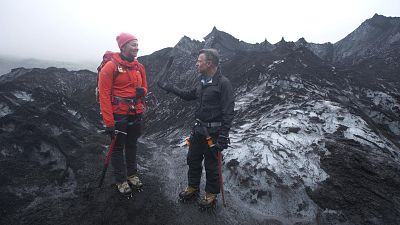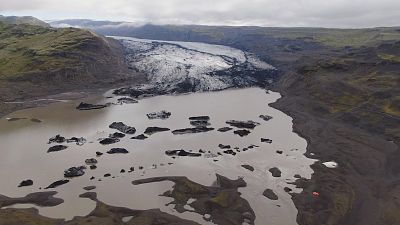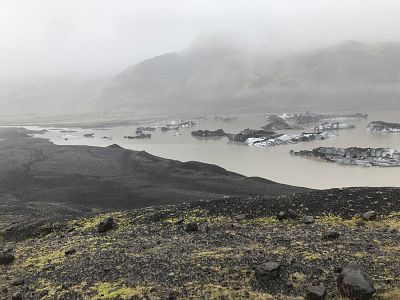One Icelandic glacier is receding annually by the length of an Olympic swimming pool. This is what scientists are doing about it.
SÓLHEIMAJÖKULL GLACIER, Iceland — To first-time visitors, it is a picturesque sight: a large lagoon dotted with kayakers and framed by lush green hills and an imposing, snake-like glacier.
But to Sigurrós Arnardóttir, a master's student in glacial geology at the University of Iceland, the view is "horrifying" for its constant reminder that climate change is destroying glaciers and causing sea levels to rise.
Standing at the water's edge, Arnardóttir, a researcher and guide at Iceland's Sólheimajökull glacier, describes how the lagoon—a product of glacial runoff—didn't exist 10 years ago. "This was all just ice."
Rising temperatures mean that Sólheimajökull is melting, receding annually by the length of an Olympic swimming pool. In summer months, Arnardóttir says the glacier loses almost two feet of ice per week.
Now the lagoon is 230 feet deep in parts. As it gets bigger, water seeps underneath the glacier, accelerating the melt.
"I have kind of a love-hate relationship with the lagoon because it just screams climate change," Arnardóttir adds.
Oddur Sigurðsson, a glaciologist at the Icelandic Meteorological Office, forecasts that all of Iceland's 300 or so named glaciers will melt within 200 years, raising global sea levels by 1 centimeter (0.4 of an inch).
Worldwide, 390 billion tons of glacial ice melts annually, contributing about a third to the rise in global sea levels, according to a scientific paper in the journal Nature this year.
In 2014, Sigurðsson declared another Icelandic glacier, known as Okjökull, "dead." In August he and about 100 others — including Iceland's environmentalist prime minister — held a symbolic funeral at the site of its "glacial remains." Another 55 glaciers have disappeared by Sigurðsson's count.
Mitigating climate change is "one of the top priorities of the government," Guðmundur Ingi Guðbrandsson, Iceland's environment minister, told NBC News. "We need to scale up our efforts and step up our game when it comes to solving the climate crisis."
Iceland has pledged to cut its emissions by 40% by 2030 and aims to be carbon neutral by 2040.
Perhaps the most promising example of how Icelanders are working to cut their carbon footprint lies about 70 miles northwest of Sólheimajökull. Scientists at the Hellisheidi Power Station, the world's third-largest geothermal power plant, have developed a process to capture carbon dioxide, a greenhouse gas, and inject it into rock.
The method — now five years old — has cut the plant's CO2 emissions by a third and researchers there are hoping that it will be adopted elsewhere.
Studded with volcanoes, Iceland gets about a quarter of its electricity from geothermal power: Hot rock heats rainwater underground, which, when brought to the surface, powers turbines to make electricity. But the steam produced by the turbines contains some CO2.
The process, known as CarbFix, involves extracting CO2 from the steam and showering it with water to create carbonated water. It is then pumped underground into porous basalt rock, mineralizing in about two years — significantly faster than other carbon-capture and storage methods.
The result is something that "stays buried underground as rock forever," says Edda Aradóttir, CarbFix's project manager. Unlike other CO2 storage methods, it doesn't need to be monitored for leaks.
Aradóttir believes that as the process improves it will turn the plant carbon neutral. She would like to see other polluters, including aluminum plants, adopt CarbFix to neutralize their emissions. In June, representatives from big industrial companies in Iceland committed to try it out.
"Iceland is unique in Europe in being able to do that," thanks to plentiful basalt, says Stuart Haszeldine, a geosciences professor at the University of Edinburgh.
The method is attracting interest from others in the field. Climeworks, a Swiss company that pioneered direct air capture of CO2, is testing at the Hellisheidi Power Station.
But CarbFix is still small scale, storing 12,000 tons of CO2 emitted by the plant each year. By contrast, a gas power plant emits about 800,000 tons of CO2 annually.
Critics question if the CarbFix method can be scaled. Cost is the biggest hurdle: Without incentives like tax credits for storing CO2, there isn't much reason for emitters to adopt it. "There is no price on polluting," Haszeldine said.
Others argue that carbon-capture strategies have little prospect of meaningfully reducing emissions and that policymakers should instead focus on expanding renewables.
Back at Sólheimajökull, Arnardóttir can't help but feel despondent about the melting glaciers. "This upsets me every time I come here," she says, pointing to a runoff stream of melted ice.
The glaciers, she says, are "almost just like big living things."
"It feels like they're bleeding."
More tonight on NBC Nightly News with Lester Holt, as part of NBC News' week-long series Climate in Crisis.














